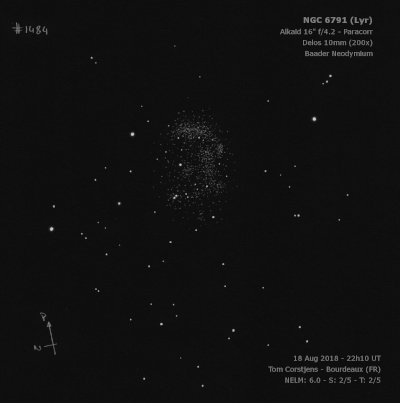
NGC 6791 is one of the very oldest open clusters, along with Berkeley 17, with an age of 8 to 10 Gyr!
Friedrich August Winnecke discovered NGC 6791 = Au 45 in December 1853 with his 2.8-inch Merz refractor. At the time he was an 18-year old astronomy student at Gottingen University. He described the cluster (repeated in Auwers' 1862 list of new nebulae) as "very faint; a miniature image of M74", so the cluster was clearly not resolved. But at Königsberg, Auwers noted that it consisted of many mag 12 stars that appeared nebulous in smaller instruments. Horace Tuttle independently discovered the cluster on 17 Jul 1859 with a 10-cm comet-seeker at Harvard College observatory (announced in AN 1453).
200/250mm - 8" (9/11/82): moderately large, very faint hazy patch like a low surface brightness galaxy, no resolution.
300/350mm - 13.1" (9/11/82): fairly faint, moderately large, many faint stars are resolved over haze with averted, low surface brightness.
600/800mm - 24" (8/12/15): gorgeous field at 200x (1/2°) using a 13mm Ethos, but this rich cluster was superbly resolved at 200x using a 10mm Zeiss Ortho. Roughly 100 stars were visible in an irregular oval outline, slightly elongated NW to SE. The stars are remarkably uniform but slightly brighter along the southeast edge. Interestingly, a large percentage of the resolved stars form the outline as the center is richer and contains more fainter stars (like a very weakly compressed globular cluster). A string of stars extends roughly through the center, bisecting the oval and a "void" is created by this string on the southeast interior. The outline is fairly well-defined, with some brighter field stars beyond, including a couple of mag 10-10.5 stars off the south side and a mag 9.5 star 11' NW of center. Excellent cluster!
Notes by Steve Gottlieb